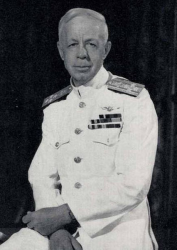
 |
|
|
||
|
Harry Ervin Yarnell |
||||
|
Graduate, U.S. Naval Academy, Class of 1897 Engagements: • Spanish-American War (1898)• World War I (1914 - 1918)• World War II (1941 - 1945) |
||||
| Biography: | ||||
|
Harry Ervin Yarnell Admiral, U.S. Navy Harry Ervin Yarnell was born on 18 October 1875 near Independence, IA. He entered the U.S. Naval Academy in 1893. After serving on USS Oregon (BB-3) during the Battle of Santiago de Cuba, 3 July 1898, Yarnell was commissioned Ensign 1 July 1899 and reported to the Asiatic Station. He served in the Philippines during the Philippine-American War and with the Asiatic Squadron during the Boxer Rebellion. In 1902, he was the Commissioning Commanding Officer of the destroyer USS Dale (DD-4). From Asia, Yarnell reported to USS Connecticut (BB-18) at her commissioning, and sailed around the world with the Great White Fleet. After that he had duty at the Newport Torpedo Station, on CINOLANT's staff, and at the Naval War College, until World War I, when he served at Gibraltar and then at London, on the staff of Admiral William S. Sims. Post-WWI Assignments Yarnell then rotated between sea and shore duty until ordered to aircraft carrier USS Saratoga (CV-3) September 1927, as prospective commanding officer. He served as Captain of the carrier from her commissioning until 17 August 1928, when he was appointed Chief of the Bureau of Steam Engineering as Rear Admiral. While in the capacity of advising the General Board on the design of a fleet submarine, Yarnell opposed smaller types, presciently noting, "our prospective opponent [Japan] has always started operations by attacking before a declaration of war." From January to April 1930, Yarnell was Naval Adviser to the American delegation at the London Naval Conference. In February 1932, Yarnell pioneered carrier tactics in an exercise that later came to be discussed as Fleet Problem 13. Rear Admiral Yarnell commanded the carriers USS Lexington and Saratoga in an effort to demonstrate that Hawaii was vulnerable to naval air power. The expectation was that Yarnell would attack with battleships, but instead he left his battleships behind and proceeded only with his carriers to the north of Hawaii where it was less likely he would be detected. With a storm as cover, at dawn on Sunday, 7 February, Yarnell's 152 planes attacked the harbor from the northeast, just as the Japanese would do ten years later. The Army airfields were first put out of commission after which battleship row was attacked - with multiple hits on Navy ships. No defending aircraft were able to launch. The Navy's war-game umpires declared the attack a total success, prompting Yarnell to strenuously warn of the Japanese threat. The New York Times reported on the exercise, noting the defenders were unable to find the attacking fleet even after 24 hours had passed. U.S. intelligence knew Japanese writers had reported on the exercise. Ironically, in the U.S., the battleship admirals voted down a reassessment of naval tactics. The umpire's report did not even mention the stunning success of Yarnell's exercise. Instead they wrote, "It is doubtful if air attacks can be launched against Oahu in the face of strong defensive aviation without subjecting the attacking carriers to the danger of material damage and consequent great losses in the attack air force." On 30 October 1936, he became Commander-in-Chief, Asiatic Fleet, with the rank of Admiral. His tour there was notable for the sagacious and firm manner with which he handled a most explosive international situation. World War II Service After three years' service commanding the Asiatic Fleet, Admiral Yarnell was transferred to the Retired List. However, as war loomed on 1 November 1941, he was recalled to the office of the Secretary of the Navy as Special Adviser to the Chinese Military Mission. Admiral Yarnell was relieved of active duty 15 January 1943, but returned in June as Head of a Special Section in the Office of Chief of Naval Operations until December 1944, when he again was relieved of active duty. Medals and Awards Among the awards and medals earned in his long and distinguished career were the Navy Cross, the Distinguished Service Medal, the Diploma and Decoration of the Companion of the Order of the British Empire, and the Cloud Standard, Second Class, of the Government of China. Honors The USS Harry E. Yarnell (DLG-17) was named in his honor. Death and Burial Admiral Harry Ervin Yarnell died on 7 July 1959 at Newport, RI, his home since retirement from the Navy. He is buried at Berkeley Memorial Cemetery in Middletown, Newport County, RI. |
||||
| Honoree ID: 690 | Created by: MHOH | |||
Ribbons
Medals
Badges
Honoree Photos
 |  |  |
 |  |
 |


